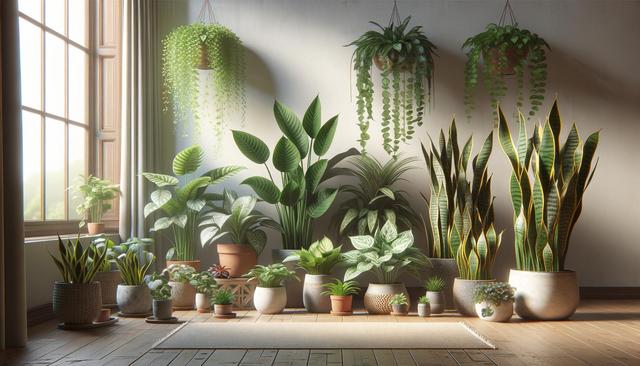Why Choose Indoor Plants?
Indoor plants do more than just brighten up a room. They can improve air quality, reduce stress, and bring a touch of nature into your daily life. For beginners, the idea of plant care might seem daunting, but starting with easy-to-manage species can ease the transition. Indoor plants are especially appealing for those in urban environments, apartments, or climates that don’t allow for year-round outdoor gardening. These plants thrive in pots and require only a modest level of attention to stay healthy and vibrant.
Some of the benefits of indoor plants include:
- Improved indoor air quality by filtering toxins
- Enhanced mood and reduced stress levels
- Aesthetic appeal for home and office spaces
- Increased humidity in dry environments
Choosing plants that are known for their resilience and low-maintenance nature makes it easier for beginners to enjoy these benefits without feeling overwhelmed.
Top Qualities to Look For in Beginner-Friendly Plants
When selecting your first indoor plants, it’s important to consider certain traits that make them suitable for new plant parents. Look for species that are tolerant of a range of light conditions, can go a few days without water, and are less prone to pests and diseases. These characteristics reduce the chances of early mistakes leading to plant loss and help build confidence in plant care skills.
Key traits to prioritize include:
- Low light requirements
- Drought tolerance
- Slow to moderate growth rate
- Minimal pruning or upkeep
These features make the plants more forgiving and easier to care for, which can be especially helpful for people with busy schedules or those new to gardening. Choosing wisely at the beginning sets the stage for a more enjoyable and successful indoor gardening experience.
Popular Indoor Plants That Are Easy to Maintain
Several indoor plants are widely recommended for beginners due to their hardiness and low care needs. These include both leafy green varieties and those with unique appearances, offering both beauty and simplicity in one package. Some well-known easy-care options include:
- Snake Plant: Known for its upright, sword-like leaves and tolerance for low light
- Pothos: A trailing plant that grows well in various lighting and watering conditions
- ZZ Plant: Features thick, waxy leaves and requires minimal water
- Peace Lily: Offers attractive white blooms and can tolerate low light
- Spider Plant: Fast-growing with interesting leaf patterns and easy propagation
These plants not only survive but often thrive in less-than-ideal conditions, which makes them ideal for anyone just starting out. Their adaptability also means they can be moved between rooms or offices without much trouble, providing flexibility in interior design.
Basic Care Tips to Keep Your Plants Thriving
Even the easiest plants need some attention. Understanding a few basic care principles will go a long way in helping your indoor plants flourish. The main factors to consider are light, water, humidity, temperature, and potting medium. Providing the right balance of these elements helps keep your plants healthy and vibrant.
Here are some general care guidelines:
- Light: Place plants according to their sunlight needs—some prefer direct light, others do well in shade.
- Water: Water only when the top inch of soil feels dry. Avoid overwatering, which can lead to root rot.
- Humidity: Most indoor plants enjoy a bit of humidity. Consider misting occasionally or using a humidity tray.
- Temperature: Keep plants in a stable environment, avoiding cold drafts and direct heat sources.
- Soil: Use well-draining potting soil suitable for indoor plants.
Consistency is key. Try to check on your plants regularly, even if they don’t need daily care. This habit can help catch early signs of issues like pests or nutrient deficiencies before they become serious problems.
Common Mistakes and How to Avoid Them
Beginners can sometimes run into trouble with indoor plants, but most common issues are easy to prevent with a little knowledge. Overwatering is perhaps the most frequent mistake, as many new plant owners assume more water is always better. In reality, many indoor plants prefer to dry out between waterings. Another common issue is placing a plant in the wrong lighting condition, which can lead to slow growth or yellowing leaves.
Here are a few tips to avoid typical pitfalls:
- Don’t water on a strict schedule—check the soil moisture first.
- Learn your plant’s light requirements and match them to your home’s conditions.
- Repot plants only when necessary to avoid stressing the roots.
- Keep an eye out for signs of pests such as sticky leaves or small webbing.
- Clean the leaves occasionally to help the plant breathe and photosynthesize efficiently.
Taking the time to understand your plant’s needs and responding accordingly can help prevent these common errors. With practice and observation, plant care becomes more intuitive over time.
Conclusion: A Green Start to Your Indoor Garden
Starting with easy indoor plants is a great way to enjoy the benefits of greenery without feeling overwhelmed. By choosing hardy, adaptable varieties and learning a few basic care techniques, beginners can build confidence and enjoy a thriving indoor garden. Whether you’re looking to brighten up a small apartment or add life to your workspace, these plants offer a simple and satisfying introduction to plant care. As you gain experience, you may find yourself ready to explore more diverse and challenging species, growing your indoor jungle one pot at a time.






